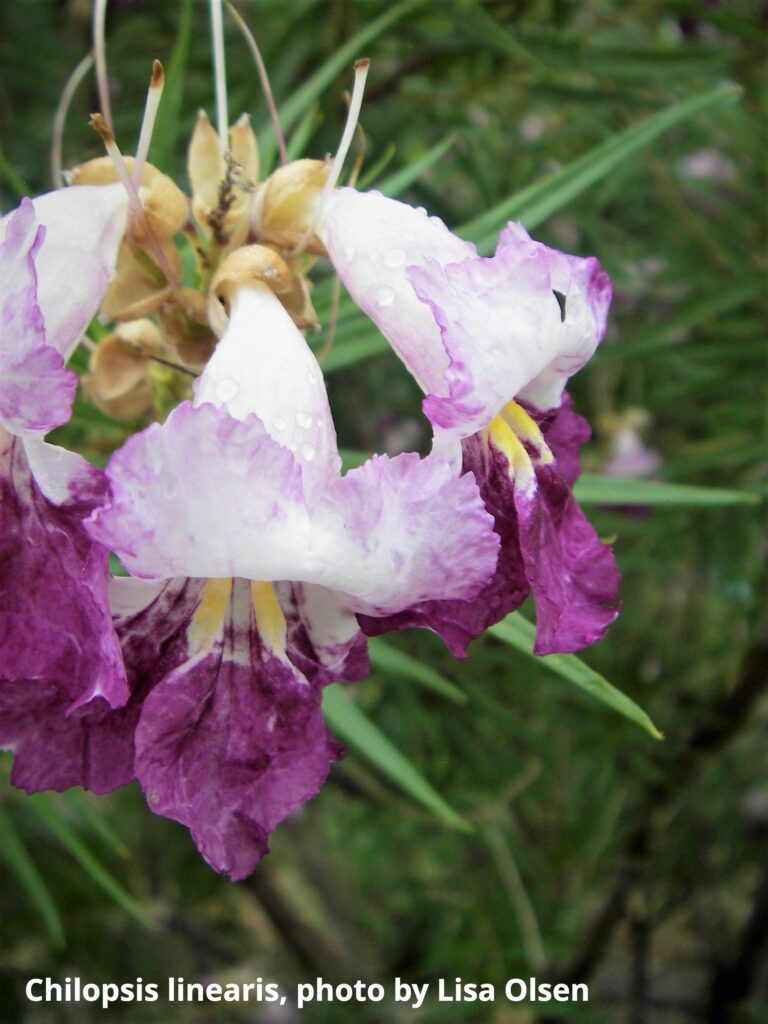By Deb Lebow Aal, inspired by a Front Range Wild Ones newsletter reader’s thoughtful response to Deb’s last article
Our April 2021 edition of the Wild Ones, Front Range Chapter newsletter contained an article on Climate Change and your yard. Within that article, we discussed assisted migration of plants, given our warming climate. We gave the Chilopsis linearis, or desert Willow as an example plant, and we received another opinion regarding the planting on the Desert Willow on the Front Range of Colorado.
Assisted migration is a big topic, with many facets and lots of ongoing research, and we only scratched the surface of this topic. So, here is another point of view, from David Salman, Chief Horticulturist (and founder of), High Country Gardens.
If you recall, the conclusion we reached in April’s article is to probably avoid planting a Desert Willow. Here’s an excerpt from the April article:
Aside from all these things we know we should do, I really wanted to know whether we should be assisting the migration of plants north, in anticipation of what will be happening with climate change. Specifically, can I plant a Desert Willow (Chilopsis linearis), because it is native to New Mexico and parts south, and hope for it to do well here? Can I call it an “almost native?” It sounds like quite a naïve question, doesn’t it? Yet it is not a simple question with a simple answer, and I wanted to know.
The short answer (and remember, I am NOT a scientist) is probably not. Although many plants have shifted their ranges northward in recent years, on average about 4-10 miles per decade, we just don’t know how wildlife will react to this change. Many conservation biologists caution that the risk of damaging ecosystems is too great, and that the chances of accidentally introducing an invasive species and doing harm, are too high. Ecologists have predicted that warming temperatures will move species northward, or to higher elevations, but the research is showing that many tree populations in the U.S. are tending to move westward, instead (not the individual tree, of course, but its progeny). The theory is that these shifts are driven more by moisture than temperature, but no one knows for sure.
David’s response to this is:

“The risk of damaging the native plant ecology of an urban, suburban or highly impacted rural area by introducing a native from outside the region is non-existent. These are already highly altered ecosystems that will never return to even a semblance of their original state. The most important natives to use are those that can survive these man-induced imbalances of these densely peopled areas.
Planting into relatively undisturbed plant habitat is another matter. It’s imperative that genetic balance is maintained by using locally collected seed or seedlings grown from locally collected seed.
In New Mexico, I’m advocating moving cold hardy Chihuahuan species and species from southern Sky Island mountain ranges of New Mexico and eastern Arizona for planting further north. These plants can thrive in hotter, drier conditions with erratic periods of wet and dry. For the Front Range of Colorado, plants from the drier, more drought-prone southern Great Plains (panhandle of Texas, Eastern New Mexico, Western Oklahoma and Western Kansas) will be among some of the best natives to bring north.”
The article also discussed the polar vortex as a reason for perhaps not assisting the migration of plants that are native to parts south or warmer than the Front Range.
David’s response to this is:
“Which brings me to planting Desert Willow (Chilopsis linearis) in Colorado. Desert willow is a wide ranging species found from the southern Great Plains of New Mexico south and west through the Chihuahuan desert, Sonoran desert and into the Mojave desert of southern CA. Chilopsis from the Sonoran and Mojave deserts will be more cold tender. On the other hand, field work done by myself and others has established cold hardy populations of Chilopsis from the plains of eastern New Mexico. The Eastern Plains of New Mexico as well as the western third of Texas have, over the past many thousands of years, been subjected to these same icy, subzero polar air vortexes that sweep over the Front Range. There are Desert Willows of unknown origins that have thrived for years in Pueblo, which has a much hotter and colder climate than Denver. Two old cultivars that have been in the trade for years, ‘Lucretia Hamilton’ and ‘Hope’ have thrived as windbreak plantings at the Los Lunas USDA Plant Materials Center for over half a century. Los Luna has experienced two Arctic Vortex lows of -20° F since 1979.
In conclusion, I can recommend planting Chilopsis from Denver south along the Front Range as well in the Western Slope of Colorado if the plants are seed grown from Southern Great Plains populations or proven cold hardy cultivars. And that plants native to the hotter, drier Southern Great Plains are some of the best ones to assist their migration to the Front Range.”
David’s view is that it is very important for us native plant lovers to keep an expansive view about the use of native plants and encourage their use. We, at Wild Ones’ Front Range chapter, continue to encourage you to write to us if you have a view you would like expressed on anything we write. We are encouraged by the interest in native plants occurring everywhere, now. So, thank you, David Salman.
Note that High Country Gardens does sell Chilopsis linearis.
